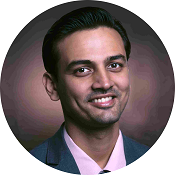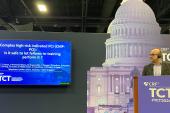The Hidden Demands of Cardiology Training
Perhaps it’s time to rethink how much personal sacrifice is necessary in the name of learning to become a physician.

Early on a Thursday morning, a day after my general cardiology board examination, I pulled myself up from my cozy bed. Getting to the hospital, with another exam behind me, there was no time to rest. Donning my scrubs, I was back to the cath lab. Mornings were growing darker and darker.
I felt both a mix of exhaustion and purpose driving me forward. The past several years were a series of blurry snapshots: long shifts, countless hours of study, and the unyielding pursuit of mastery. With all of the drudgery and often monotonous routine, I started thinking about what it takes to provide the best care for our patients.
I had been told that it’s all about putting in long hours, learning every possible pathology, and making the right decisions under pressure. While that’s partly true, I don’t think it ends there. Each day isn’t just about patient care, it’s also about continually expanding one’s knowledge by absorbing information from textbooks, board review materials, journal articles, guidelines, and lectures. Then there’s the oft-overlooked administrative burden of refreshing your CV, attending conferences, preparing for interviews, and on and on. Don’t forget the research, either—always pushing to prove our commitment to our specialty. It’s an endless river of to-do-lists, with a destination that keeps on shifting downstream.
While the Accreditation Council for Graduate Medical Education (ACGME) accounts for clinical hours, most good clinical training programs ensure that our duty-hour log is close to the threshold. Outside these hours, time that could have been spent recovering and recharging is inevitably spent taking care of this overhead. We’re all familiar with late nights, early mornings, weekends, and stolen moments of rest taken from hobbies, family gatherings, friends, and ultimately from ourselves. In exchange, we gain resilience in the ability to push through and stand beside our patients in their most vulnerable moments. Frequently hailed as a defining trait of physicians, this resilience is seen as a badge of honor symbolizing the capacity to endure challenges. It is sculpted through repeated exposure to difficult situations—pushing our limits until we adapt. But like any sharp tool, it can cut both ways. Studies have shown that even highly resilient physicians are not immune to burnout, indicating that systemic factors, such as the culture of equating dedication with sacrifice, play a significant role in normalizing stress.
True resilience, however, is not just the ability to withstand or silently absorb pressure, it’s about finding ways to thrive under it. Resilience should involve developing tools to navigate training while staying true to what really matters. Perhaps it’s time to rethink this important character trait as being not a means to endure or compromise but a foundation for fostering environments where physicians can truly excel.
New Tools Are a Resource
As I reflect on the challenges of training, it becomes clear that there are opportunities to streamline learning and reduce unnecessary burdens. Maybe that means retooling the structures and systems that define our learning? How can we foster an environment that not only produces competent clinicians but also values their humanity and supports their growth outside of medicine?
In an era defined by rapid technological advancements, the medical field has only begun to scratch the surface of how technology can transform training. Administrative tasks, including clinical documentation and paperwork, consume hours that could otherwise be spent on learning or recovery. A report by the American College of Physicians highlights how excessive administrative work diverts focus from clinically significant activities, contributing to burnout and inefficiencies in healthcare delivery. By integrating technology into these processes, we can reclaim valuable time and refocus on patient care and professional growth.
Take artificial intelligence (AI), for example. AI-powered tools can streamline documentation by auto-generating clinical notes, flagging inconsistencies, or integrating seamlessly with electronic medical records. These tools can also tailor chart reviews to individual cases and automate critical communication between different teams, thereby reducing redundancies. Virtual assistants designed for medical use could help trainees organize paperwork for the next phase of their careers, which would save hours.
AI-driven personalized tutors or ‘gurus’ could provide individualized coaching by understanding each trainee’s baseline and tailoring recommendations to their unique goals. Harvard Medical School, for example, has demonstrated how AI can revolutionize medical education, providing opportunities for personalized learning experiences and simulation-based platforms that allow trainees to practice complex procedures in a low-risk environment. Building on these capabilities, AI-powered tools could be modeled after field leaders, amplifying access to expert mentorship and tailored guidance. Though technology is not a replacement for hard work, it is a valuable ally in alleviating inefficiencies that can drain time and energy.
The question isn’t whether we should integrate these tools, but how quickly we can implement them to better support our trainees. While some technologies are not yet fully developed, they are only a few steps away from becoming indispensable. By leveraging technology, we can reduce overhead, streamline workflows, and create a training environment that prioritizes learning, innovation, and well-being.
Fostering a Culture of Support and Growth
Beyond technology, meaningful change in medical training requires a cultural shift that moves away from equating sacrifice with dedication. The culture of medicine has long celebrated endurance and self-reliance, often at the expense of well-being. Since trainees spend most of their waking hours in the hospital, programs should incorporate protected time into schedules for activities such as reading, exercise, or meditation. Given that these years of training tend to extend well into one’s 30s, such changes would allow trainees to be truly present for their families when they finally reach home, rather than carrying the weight of unrelenting demands. By prioritizing such initiatives, we can build an environment that values both clinical excellence and personal growth, laying the groundwork for more compassionate and balanced physicians.
As we reflect on the “overhead” of medical training—the sometimes-invisible challenges and demands—it becomes evident that the system, while effective in producing competent clinicians, requires hours that ripple far beyond the hospital walls. The time has come to rethink how we approach training—not by abandoning its rigor, but by balancing it with structures that promote well-being, growth, and sustainability. By integrating technology, fostering cultural change, and prioritizing protected time for self-care, we can enable trainees to thrive both professionally and personally. These changes are investments not only in trainees but also in the future of healthcare, ensuring tomorrow’s physicians are skilled, resilient, and compassionate.
Tushar Mishra, MD, is a second-year general cardiology fellow at Wayne State University/Detroit Medical Center in Detroit. Raised in India…
Read Full Bio




Comments